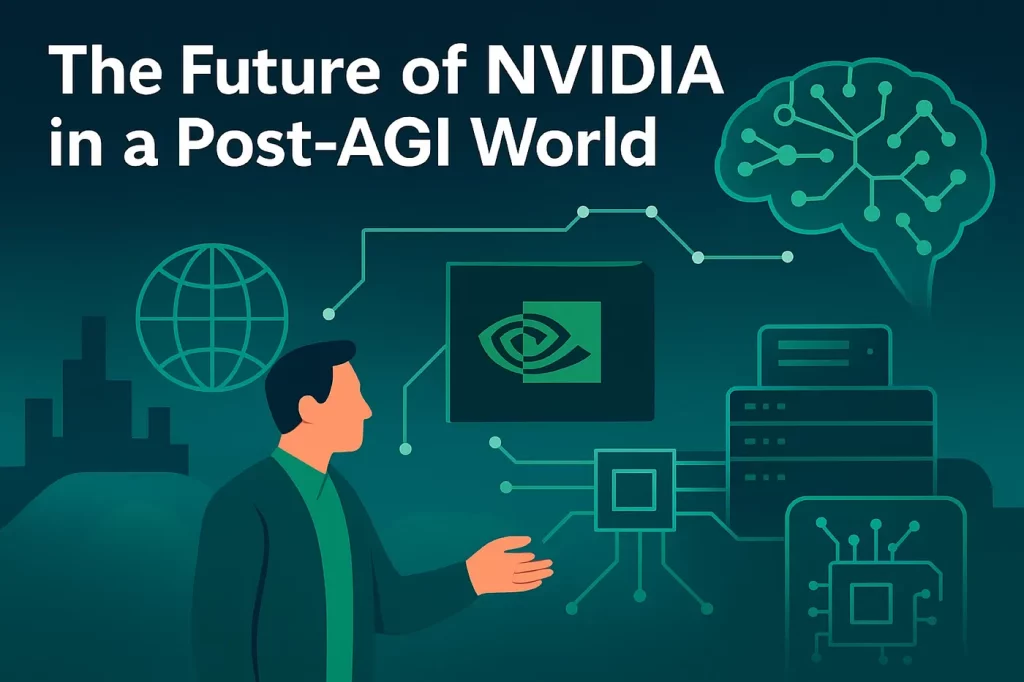When artificial general intelligence finally arrives, what will happen to Nvidia?
It’s a serious question. For years, Nvidia has been known as the company that designs the world’s fastest GPUs – chips that power video games, research, and now the explosion of artificial intelligence. But if AGI can one day design better chips and software entirely on its own, what is left for Nvidia to do?
The answer might determine whether Nvidia remains the most important technology company of its generation, or becomes the next Intel – a fallen giant overtaken by the very revolution it helped to create.

From Gaming to the Heart of the AI Economy
Nvidia began in 1993 as a small California start-up building graphics cards for gaming PCs. Its big idea was that graphical processing could be separated from general computing, allowing the GPU to specialize in rendering complex images faster than any CPU.
That simple insight turned into a new paradigm. Over the following decades, Nvidia transformed the GPU from a niche gaming accessory into a cornerstone of modern computing. With the introduction of CUDA in 2007, Nvidia unlocked something extraordinary: GPUs could be programmed for general-purpose computing, not just graphics. Suddenly, the same chips that powered 3D games could train neural networks and process vast datasets – the foundation of modern AI.
By the early 2020s, Nvidia was no longer just a hardware manufacturer. It had become the beating heart of the AI economy, providing the chips, software, and infrastructure that enable artificial intelligence itself.
The Coming Disruption: When AGI Designs the Designer
But AGI changes everything. Once machines can design and optimize hardware and software better than human engineers, the traditional barriers of entry that protect companies like Nvidia could disappear overnight.
If any startup – or even an AI model – can generate a new chip architecture in seconds, the competitive edge built on human R&D would vanish.
Nvidia seems aware of this, and its strategy has already begun to evolve. The company is no longer trying to win only by designing the best chips. It is trying to become the operating layer of the AI world – the glue between computation, energy, and intelligence.
Through its software platforms like CUDA and Omniverse, Nvidia aims to orchestrate how AI systems communicate and operate. Its growing investments in data centers and supercomputing infrastructure – often alongside Microsoft, Oracle, or CoreWeave – show that Nvidia wants to be deeply embedded in the physical backbone of AI.
Even if AGI takes over chip design, Nvidia would still control the infrastructure where AGI runs. That’s a position of immense structural power.
From Manufacturer to Holding of the AI World
In this emerging paradigm, Nvidia’s future looks less like a traditional semiconductor firm and more like a hybrid: part infrastructure operator, part holding company.
Instead of owning the fabs or the energy grids, Nvidia invests capital, expertise, and software standards into the global AI supply chain. It acts as the orchestrator – ensuring that superclusters run efficiently, GPUs interconnect properly, and energy use remains optimized.
In a world where intelligence is cheap and design is automated, control over operations becomes the last durable moat.
This is why Nvidia co-finances massive AI data centers and partners closely with hyperscalers. If the company can secure a stake in the world’s most critical computing infrastructure, it can remain indispensable – even if the creative aspect of chip design becomes automated.
The Intel Lesson: What Happens When You Stop Looking Forward
Intel’s story is a warning. For decades, it dominated the computing industry. “Intel Inside” became a household phrase, synonymous with performance and reliability. But its fall from dominance was not sudden – it was the slow erosion of a company that stopped looking forward.
Intel relied too heavily on its x86 architecture, comfortable with its near-monopoly in CPUs. It underestimated the rise of GPUs, cloud computing, and mobile devices. When the industry began shifting toward parallel computing and energy efficiency, Intel’s pace of innovation faltered.
Manufacturing delays in the 2010s – especially the long struggle to move from 14nm to 10nm – eroded confidence. Meanwhile, competitors like AMD, TSMC, and ARM advanced rapidly. Hyperscalers like Amazon and Google began designing their own chips.
Most damaging of all, Intel failed to control the ecosystem around its products. It made chips but didn’t shape the software, the infrastructure, or the platforms where those chips operated. Nvidia learned from that mistake.
Intel was reactive. Nvidia is being proactive – moving from component maker to infrastructure architect.
The Real Battle: Structural Relevance
In the end, AGI won’t destroy all companies. It will destroy the ones that are structurally irrelevant.
Design, code, and optimization can all be automated. But physical execution – the energy, materials, logistics, and coordination that connect silicon to computation – cannot.
Nvidia’s current trajectory suggests it understands this. Its deep involvement in global AI clusters, its expansion into simulation ecosystems like Omniverse, and its partnerships with the biggest cloud players all point toward the same goal: ensuring that no AGI can function at scale without Nvidia somewhere in the loop.
That’s not a design moat – it’s an operational one. And in the age of artificial general intelligence, that’s the only kind that matters.
The Takeaway for Investors
For investors, the question isn’t whether Nvidia will continue to dominate GPUs. It’s whether Nvidia will secure structural influence over the next generation of AI infrastructure.
The signals to watch are clear:
• Is Nvidia increasing its ownership or operational control of AI superclusters?
• Are its partnerships with hyperscalers deepening rather than weakening?
• Does its software ecosystem (CUDA, Omniverse, AI Enterprise) remain irreplaceable for running AI workloads?
If the answer to these questions remains yes, Nvidia is positioned not just to survive AGI – but to become one of the few companies that define it.
Conclusion
Nvidia’s transformation mirrors the evolution of computing itself. From gaming GPUs to AI accelerators to global infrastructure, it has consistently reinvented its purpose ahead of the curve.
Intel once had the same opportunity – and missed it.
The next decade will test whether Nvidia can do what Intel could not: move beyond technological leadership and secure structural permanence.
In the post-AGI world, only the companies that control the bridges between intelligence and matter will remain truly indispensable. Nvidia’s challenge is to make sure it builds those bridges before anyone else does.


